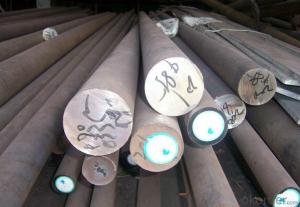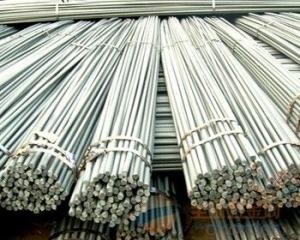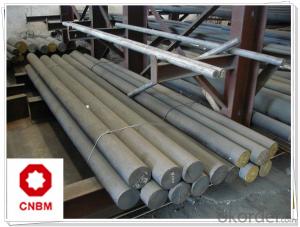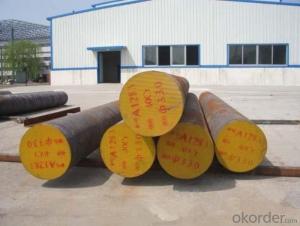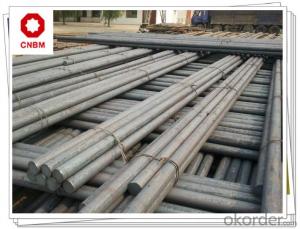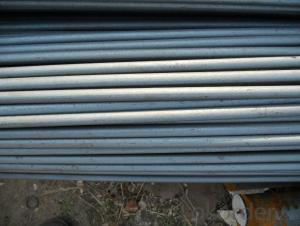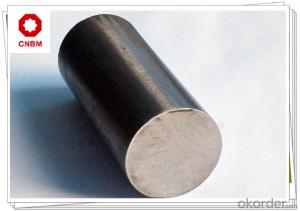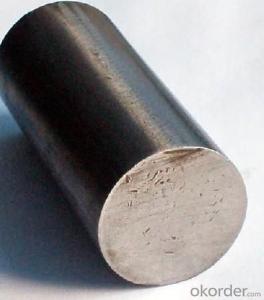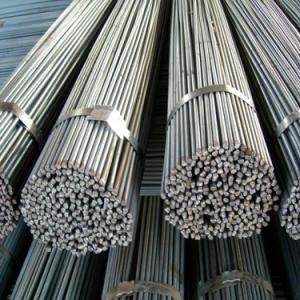SS400 Round Bar Chromed Steel Round Bar-Steel Round Bar
- Loading Port:
- Tianjin
- Payment Terms:
- TT OR LC
- Min Order Qty:
- 25 m.t.
- Supply Capability:
- 20000 m.t./month
OKorder Service Pledge
OKorder Financial Service
You Might Also Like
Specification
Product Description:
OKorder is offering SS400High quality Round Bar Chromed Steel Round Bar-Steel Round Bar Sat great prices with worldwide shipping. Our supplier is a world-class manufacturer of steel, with our products utilized the world over. OKorder annually supplies products to European, North American and Asian markets. We provide quotations within 24 hours of receiving an inquiry and guarantee competitive prices.
Product Applications:
SS400 Round Bar Chromed Steel Round Bar-Steel Round Bar are ideal for structural applications and are widely used in the construction of buildings and bridges, and the manufacturing, petrochemical, and transportation industries.
Product Advantages:
OKorder's SS400 Round Bar Chromed Steel Round Bar-Steel Round Bar are durable, strong, and resist corrosion.
Main Product Features:
· Premium quality
· Prompt delivery & seaworthy packing (30 days after receiving deposit)
· Corrosion resistance
· Can be recycled and reused
· Mill test certification
· Professional Service
· Competitive pricing
Product Description:
Specifications of High Quality Round Bar
1. Grade: GB, JIS, ASTM, EN
2. Grade: Q235, SS400, A36, S235JR
3. Diameter and mass: As below
Diameter | Mass | Diameter | Mass | Diameter | Mass |
(mm) | (kg/m) | (mm) | (kg/m) | (mm) | (kg/m) |
6 | 0.22 | 22 | 2.98 | 53 | 17.30 |
7 | 0.30 | 24 | 3.55 | 56 | 19.30 |
8 | 0.40 | 25 | 3.85 | 60 | 22.20 |
9 | 0.50 | 26 | 4.17 | 63 | 24.50 |
10 | 0.62 | 28 | 4.83 | 65 | 26.00 |
11 | 0.75 | 30 | 5.55 | 70 | 30.20 |
12 | 0.89 | 32 | 6.31 | 75 | 34.70 |
13 | 1.04 | 34 | 7.13 | 80 | 39.50 |
14 | 1.21 | 36 | 7.99 | 85 | 44.50 |
15 | 1.39 | 38 | 8.90 | 90 | 49.90 |
16 | 1.58 | 40 | 9.86 | 95 | 55.60 |
17 | 1.78 | 42 | 10.90 | 100 | 61.70 |
18 | 2.00 | 45 | 12.50 | 120 | 88.85 |
19 | 2.23 | 48 | 14.20 | 140 | 120.93 |
20 | 2.47 | 50 | 15.40 | 150 | 138.82 |
4. Material: Mild Steel
5. Heat treatment of high quality steel:
Fire: Isothermal annealing temperature is 800 ~ 880 °C, with 10 ~ 20 °C, the furnace cooling to about 600 °C, hardness above HB269.
FAQ:
Q1: Why buy Materials & Equipment from OKorder.com?
A1: All products offered byOKorder.com are carefully selected from China's most reliable manufacturing enterprises. Through its ISO certifications, OKorder.com adheres to the highest standards and a commitment to supply chain safety and customer satisfaction.
Q2: How do we guarantee the quality of our products?
A2: We have established an advanced quality management system which conducts strict quality tests at every step, from raw materials to the final product. At the same time, we provide extensive follow-up service assurances as required.
Q3: Can stainless steel rust?
A3: Stainless does not "rust" as you think of regular steel rusting with a red oxide on the surface that flakes off. If you see red rust it is probably due to some iron particles that have contaminated the surface of the stainless steel and it is these iron particles that are rusting. Look at the source of the rusting and see if you can remove it from the surface.
Images:


- Q: What are the different types of steel round bar profiles?
- There are several different types of steel round bar profiles available in the market. Some of the most common profiles include: 1. Plain Round Bar: This is the most basic and commonly used profile. It is a solid cylindrical bar with a smooth surface and uniform diameter throughout its length. 2. Deformed Round Bar: This type of round bar has deformations or ribs along its surface. These deformations provide better bonding with concrete when used in reinforced concrete structures, making it ideal for construction applications. 3. Hollow Round Bar: As the name suggests, this profile has a hollow center. It is often used in industries where weight reduction is important or where the round bar needs to be used as a conduit for fluids or gases. 4. Threaded Round Bar: This profile has threads along its length, allowing it to be easily screwed into other components. It is commonly used in applications where secure fastening or adjustability is required. 5. Half-Round Bar: This profile has a flat side and a rounded side, giving it a semi-circular shape. It is often used in decorative applications, such as handrails, where a sleek and aesthetically pleasing appearance is desired. 6. Square Bar: Although not strictly a round profile, square bars are often included in this category. These bars have four equal sides and are commonly used in applications where higher torsional strength is required. 7. Hexagonal Bar: Similar to square bars, hexagonal bars have six equal sides. They are often used in applications where high torque resistance is needed or when a distinctive appearance is desired. These are just some of the different types of steel round bar profiles available. The choice of profile depends on the specific application requirements, such as structural strength, bonding capabilities, or aesthetic considerations.
- Q: What are the advantages of using zinc-alloy steel round bars?
- There are several advantages of using zinc-alloy steel round bars: 1. Corrosion resistance: Zinc-alloy steel round bars are coated with a layer of zinc, which acts as a protective barrier against corrosion. This makes them highly resistant to rust and other forms of corrosion, ensuring a longer lifespan and durability. 2. Strength and durability: Zinc-alloy steel is known for its high strength and durability. The addition of zinc to the steel enhances its structural integrity, making it capable of withstanding heavy loads and high stress conditions. This makes zinc-alloy steel round bars suitable for various applications that require strength and reliability. 3. Cost-effective: Zinc-alloy steel round bars are cost-effective compared to other corrosion-resistant materials. The zinc coating provides a cheaper alternative to expensive metals like stainless steel, while still offering comparable corrosion resistance and strength. 4. Easy fabrication and versatility: Zinc-alloy steel round bars can be easily fabricated into different shapes and sizes, making them versatile for various applications. They can be cut, bent, welded, and machined to meet specific requirements, making them suitable for use in construction, automotive, industrial, and other industries. 5. Aesthetic appeal: Zinc-alloy steel round bars have a visually appealing appearance due to their shiny and smooth zinc coating. This makes them suitable for applications where aesthetics are important, such as architectural designs or decorative elements. 6. Environmental sustainability: Zinc is a highly recyclable material, and the use of zinc-alloy steel round bars promotes environmental sustainability. These bars can be recycled at the end of their lifespan, reducing the need for new raw materials and minimizing waste generation. Overall, the advantages of using zinc-alloy steel round bars include corrosion resistance, strength, cost-effectiveness, versatility, aesthetic appeal, and environmental sustainability. These qualities make them a desirable choice for various industries and applications.
- Q: What are the different types of steel round bar surface coatings?
- Enhancing the performance and durability of steel round bars commonly involves utilizing various surface coatings. These coatings serve as a protective layer, safeguarding against corrosion and improving the overall appearance. Several types of surface coatings are frequently employed, including: 1. Galvanized Coating: This method entails applying a zinc layer to the steel round bar. It boasts exceptional corrosion resistance, making it ideal for outdoor applications that expose the steel to moisture and harsh environmental conditions. 2. Powder Coating: In this process, a dry powder is applied to the steel round bar and then cured under heat. The result is a robust and visually appealing finish that resists chipping, scratching, and fading. Powder coating offers a wide range of colors and textures, making it a popular choice for decorative purposes. 3. Epoxy Coating: An application of liquid thermosetting polymer, which subsequently cures to form a protective layer, characterizes epoxy coating. This type of coating exhibits excellent resistance to corrosion and chemicals, making it suitable for use in harsh environments. Industries such as oil and gas, marine, and chemical processing frequently employ epoxy coatings. 4. Chrome Plating: Chrome plating involves electroplating a chromium layer onto the steel round bar. This coating provides superior corrosion resistance and enhances the steel's appearance. Chrome plating is commonly utilized in applications where both corrosion protection and aesthetics are crucial, such as automotive parts and decorative hardware. 5. Nickel Plating: Similar to chrome plating, nickel plating involves electroplating a nickel layer onto the steel round bar. This coating offers exceptional corrosion resistance and is often utilized in applications where the steel is exposed to harsh chemicals or extreme temperatures. These examples only scratch the surface of the available options for steel round bar surface coatings. The choice of coating depends on the specific requirements of the application, including the desired level of corrosion resistance, chemical resistance, and aesthetic appeal. Selecting the appropriate coating based on the intended use of the steel round bar ensures optimal performance and longevity.
- Q: What are the advantages of using steel round bars over other materials?
- There are several advantages of using steel round bars over other materials. Firstly, steel round bars offer exceptional strength and durability, making them ideal for high-stress applications. Secondly, steel has excellent heat resistance, making it suitable for use in extreme temperature environments. Additionally, steel round bars exhibit excellent machinability, allowing for easy fabrication and customization. Moreover, steel is highly resistant to corrosion, ensuring longevity and reduced maintenance costs. Lastly, steel round bars are readily available in various sizes and grades, offering versatility for a wide range of construction and industrial projects.
- Q: What are the advantages of using high-temperature steel round bars?
- Using high-temperature steel round bars in various applications has several advantages. Firstly, these bars possess excellent heat resistance properties, enabling them to withstand elevated temperatures without compromising their structural integrity. This makes them ideal for industries like aerospace, automotive, and power generation, where components are exposed to extreme heat conditions. Another advantage of high-temperature steel round bars is their superior strength and durability. They are designed to withstand high mechanical stresses, making them suitable for applications requiring heavy loads or intense pressure. Additionally, their high strength-to-weight ratio allows for lighter and more efficient designs, reducing overall material and production costs. Furthermore, high-temperature steel round bars exhibit excellent corrosion resistance properties. They can withstand exposure to harsh environments, including chemicals, moisture, and saltwater, without significant degradation. This makes them suitable for industries like marine, chemical, and oil and gas where corrosion resistance is crucial. Moreover, high-temperature steel round bars offer excellent dimensional stability, maintaining their shape and size even under extreme temperature fluctuations. This property is highly advantageous in applications where precision and accuracy are essential, such as machining and tooling. Lastly, high-temperature steel round bars are readily available in various sizes, grades, and finishes, allowing for flexibility and customization to meet specific project requirements. This versatility makes them suitable for a wide range of applications, ensuring that there is a suitable option for every project, regardless of complexity or industry. In conclusion, high-temperature steel round bars provide superior heat resistance, strength, durability, corrosion resistance, dimensional stability, and versatility. These properties make them an excellent choice for various industries and applications, guaranteeing reliable and long-lasting performance in demanding environments.
- Q: What are the different types of tests performed on steel round bars for quality control?
- There are several types of tests performed on steel round bars for quality control purposes. These tests help to ensure that the steel bars meet the required standards and specifications. Some of the common tests conducted on steel round bars include: 1. Tensile Test: This test evaluates the tensile strength, yield strength, and elongation properties of the steel bars. It involves applying a pulling force to the bar until it breaks, measuring the maximum force the bar can withstand, and determining the bar's ability to stretch without fracturing. 2. Hardness Test: The hardness test measures the resistance of the steel bar to indentation or scratching. It provides an indication of the bar's strength and durability. Common hardness tests include Rockwell, Brinell, and Vickers tests. 3. Chemical Composition Analysis: This test determines the chemical composition of the steel round bars, including the percentage of various elements such as carbon, manganese, sulfur, phosphorus, and others. It ensures that the bars meet the specified chemical composition requirements. 4. Ultrasonic Testing: Ultrasonic testing uses high-frequency sound waves to detect any internal defects or discontinuities within the steel bars. This non-destructive test helps identify cracks, voids, or other defects that may affect the bar's structural integrity. 5. Dimensional Inspection: This test ensures that the steel round bars meet the required dimensional tolerances, including diameter, length, and straightness. It involves using precision measuring instruments such as calipers, micrometers, and gauges to verify the bar's dimensions. 6. Surface Quality Examination: This test inspects the surface condition of the steel bars for any defects, such as cracks, pits, scratches, or other surface irregularities. It is crucial to ensure that the bars have a smooth and defect-free surface for proper functionality and safety. 7. Microstructure Analysis: Microstructure analysis involves examining the steel bar's internal structure under a microscope. It helps determine the grain size, inclusion content, and overall microstructural integrity of the bars. This analysis provides insights into the bars' mechanical properties and their ability to withstand various loads and stresses. By performing these tests, manufacturers can ensure that the steel round bars meet the required quality standards and are suitable for their intended applications.
- Q: What is the difference between a hot-rolled and a cold-drawn steel round bar?
- The manufacturing process and resulting properties distinguish a hot-rolled steel round bar from a cold-drawn one. To produce hot-rolled bars, a billet or ingot is heated to a high temperature, typically around 1100 to 1300 degrees Celsius, and then rolled into the desired shape and size. This process yields a rougher surface finish and larger tolerances compared to cold-drawn bars. Hot-rolled bars exhibit less precision in dimensions and may contain surface defects such as scale or rust. In contrast, cold-drawn bars undergo manufacturing by pulling a hot-rolled bar through a die at room temperature. This process reduces the diameter and enhances the surface finish, resulting in a smoother and more precise product. Cold-drawing also improves the mechanical properties of the steel, including increased strength, hardness, and improved surface quality. The cold-drawing process provides closer dimensional tolerances, making cold-drawn bars suitable for applications that demand higher precision. In conclusion, the distinction between hot-rolled and cold-drawn steel round bars lies in the manufacturing process, resulting in differences in surface finish, dimensional tolerances, and mechanical properties. Hot-rolled bars are produced at high temperatures, possess a rougher surface, and have larger tolerances. On the other hand, cold-drawn bars are manufactured at room temperature, exhibit a smoother surface, closer dimensional tolerances, and enhanced mechanical properties. The choice between the two depends on specific application requirements and the desired characteristics of the final product.
- Q: What are the environmental impacts of steel round bar production?
- The production of steel round bars has several environmental impacts. Firstly, the extraction of raw materials such as iron ore and coal required for steel production leads to habitat destruction, deforestation, and disruption of ecosystems. Mining activities also generate large amounts of waste, including tailings and waste rock, which can contaminate soil, water bodies, and air. The process of converting iron ore into steel involves high energy consumption, primarily from fossil fuels. The burning of these fuels releases greenhouse gases, such as carbon dioxide and nitrogen oxides, contributing to climate change and air pollution. Additionally, steel production releases particulate matter, sulfur dioxide, and other pollutants that can have detrimental effects on human health and ecosystems. Steel manufacturing also requires significant amounts of water for cooling, cleaning, and processing. This can lead to water scarcity and pollution if proper water management practices are not in place. Discharge of untreated or inadequately treated wastewater from steel production can contaminate nearby water sources, affecting aquatic life and potentially harming human populations who rely on these water bodies. Furthermore, the transportation of raw materials and finished steel products over long distances contributes to carbon emissions and air pollution. The energy-intensive nature of steel production and transportation further exacerbates the overall environmental impacts of the industry. To mitigate these environmental impacts, the steel industry has been implementing various measures. These include the use of more efficient technologies, such as recycling and minimization of waste, improving energy efficiency, and adopting cleaner production processes. Additionally, the industry has been focusing on reducing its carbon footprint by increasing the use of renewable energy sources and implementing carbon capture and storage technologies. Overall, while steel round bar production contributes to environmental degradation, there are ongoing efforts within the industry to minimize its negative impacts and transition towards more sustainable practices.
- Q: What is the difference between a smooth and a precision ground steel round bar?
- A smooth steel round bar has a surface that is free from any roughness or irregularities, providing a polished and sleek appearance. On the other hand, a precision ground steel round bar undergoes a specialized grinding process to achieve tight tolerances and a high degree of accuracy in its dimensions. This precision grinding ensures that the bar has consistent diameter and smoothness throughout its length, making it suitable for applications that require precise measurements and tight fits.
- Q: What are the tolerances for steel round bars?
- The tolerances for steel round bars can vary depending on the specific requirements of the application and the manufacturing process. Generally, the tolerances for steel round bars are specified in terms of diameter, straightness, and length. In terms of diameter tolerance, it is common to find tolerances ranging from +/- 0.001 inches to +/- 0.005 inches. This means that the actual diameter of the steel round bar can deviate within this range from the specified diameter. The specific tolerance will depend on the size and grade of the bar. Straightness tolerance refers to the allowable deviation in the straightness of the bar. This is typically specified as a maximum deviation per unit length, such as 0.125 inches per foot. It ensures that the bar remains straight and within acceptable limits when measured along its length. Length tolerance determines the allowable variation in the overall length of the round bar. This can range from +/- 0.125 inches to +/- 0.5 inches, depending on the size and grade of the bar. It ensures that the bar meets the required length specifications. It is important to note that these tolerances can vary depending on the industry standards, customer specifications, and the manufacturing method used. Additionally, certain applications may have more stringent tolerance requirements, especially in industries such as aerospace or automotive, where precision is critical. In summary, the tolerances for steel round bars encompass diameter, straightness, and length. The specific tolerances will depend on the size, grade, and application of the round bar, as well as any relevant industry standards or customer specifications.
Send your message to us
SS400 Round Bar Chromed Steel Round Bar-Steel Round Bar
- Loading Port:
- Tianjin
- Payment Terms:
- TT OR LC
- Min Order Qty:
- 25 m.t.
- Supply Capability:
- 20000 m.t./month
OKorder Service Pledge
OKorder Financial Service
Similar products
Hot products
Hot Searches
Related keywords
